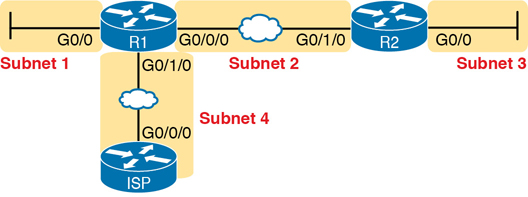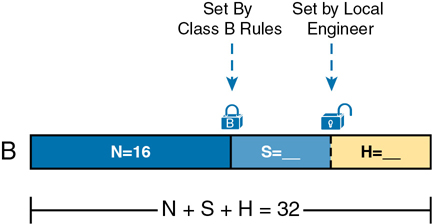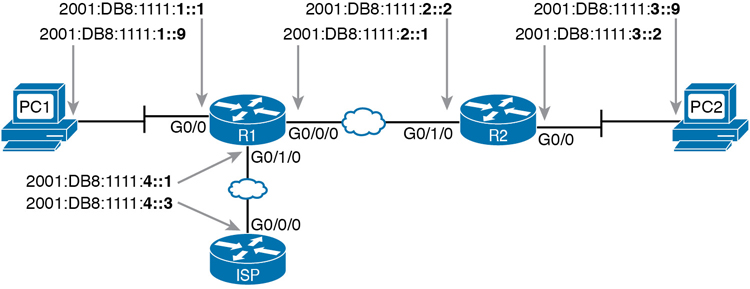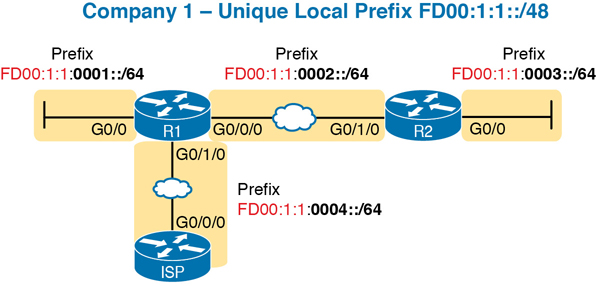Chapter 23. IPv6 Addressing and Subnetting
This chapter covers the following exam topics:
1.0 Network Fundamentals
1.8 Configure and verify IPv6 addressing and prefix
1.9 Compare and contrast IPv6 address types
1.9.a Global unicast
1.9.b Unique local
IPv4 organizes the address space in a couple of ways. First, IPv4 splits addresses by class, with Classes A, B, and C defining unicast IPv4 addresses. (The term unicast refers to the fact that each address is used by only one interface.) Then, within the Class A, B, and C address range, the Internet Assigned Numbers Authority (IANA) and the Internet Corporation for Assigned Names and Numbers (ICANN) reserve most of the addresses as public IPv4 addresses, with a few reserved as private IPv4 addresses.
IPv6 does not use any concept like the classful network concept used by IPv4. However, IANA does still reserve some IPv6 address ranges for specific purposes, even with some address ranges that serve as both public IPv6 addresses and private IPv6 addresses. IANA also attempts to take a practical approach to reserving ranges of the entire IPv6 address space for different purposes, using the wisdom gained from several decades of fast growth in the IPv4 Internet.
This chapter has two major sections. The first examines global unicast addresses, which serve as public IPv6 addresses. The second major section looks at unique local addresses, which serve as private IPv6 addresses.
“Do I Know This Already?” Quiz
Take the quiz (either here or use the PTP software) if you want to use the score to help you decide how much time to spend on this chapter. The letter answers are listed at the bottom of the page following the quiz. Appendix C, found both at the end of the book as well as on the companion website, includes both the answers and explanations. You can also find both answers and explanations in the PTP testing software.
Table 23-1 “Do I Know This Already?” Foundation Topics Section-to-Question Mapping
Foundation Topics Section |
Questions |
|---|---|
Global Unicast Addressing Concepts |
1–4 |
Unique Local Unicast Addresses |
5 |
1. Which of the following IPv6 addresses appears to be a unique local unicast address, based on its first few hex digits?
a. 3123:1:3:5::1
b. FE80::1234:56FF:FE78:9ABC
c. FDAD::1
d. FF00::5
2. Which of the following IPv6 addresses appears to be a global unicast address, based on its first few hex digits?
a. 3123:1:3:5::1
b. FE80::1234:56FF:FE78:9ABC
c. FDAD::1
d. FF00::5
3. When subnetting an IPv6 address block, an engineer shows a drawing that breaks the address structure into three pieces. Comparing this concept to a three-part IPv4 address structure, which part of the IPv6 address structure is most like the IPv4 network part of the address?
a. Subnet
b. Interface ID
c. Network
d. Global routing prefix
e. Subnet router anycast
4. When subnetting an IPv6 address block, an engineer shows a drawing that breaks the address structure into three pieces. Assuming that all subnets use the same prefix length, which of the following answers lists the name of the field on the far right side of the address?
a. Subnet
b. Interface ID
c. Network
d. Global routing prefix
e. Subnet router anycast
5. For the IPv6 address FD00:1234:5678:9ABC:DEF1:2345:6789:ABCD, which part of the address is considered the global ID of the unique local address?
a. None; this address has no global ID.
b. 00:1234:5678:9ABC
c. DEF1:2345:6789:ABCD
d. 00:1234:5678
e. FD00
Answers to the “Do I Know This Already?” quiz:
1 C
2 A
3 D
4 B
5 D
Foundation Topics
Global Unicast Addressing Concepts
This first major section of the chapter focuses on one type of unicast IPv6 addresses: global unicast addresses. As it turns out, many of the general concepts and processes behind these global unicast IPv6 addresses follow the original intent for public IPv4 addresses. So, this section begins with a review of some IPv4 concepts, followed by the details of how a company can use global unicast addresses.
This first section also discusses IPv6 subnetting and the entire process of taking a block of global unicast addresses and creating subnets for one company. This process takes a globally unique global routing prefix, creates IPv6 subnets, and assigns IPv6 addresses from within each subnet, much like with IPv4.
Public and Private IPv6 Addresses
In the history of IPv4 addressing, the world started out with a plan that gave every single host a globally unique public IPv4 address. However, as discussed in several places already, the IPv4 address space had too few addresses. So, in the 1990s, companies started using addresses from the private IPv4 address range, as defined in RFC 1918. These companies either simply did not connect to the Internet, or to connect to the Internet, they used Network Address Translation (NAT), sharing a few public globally unique IPv4 addresses for all host connections into the Internet.
IPv6 allows two similar options of public and private unicast addressing, beginning with global unicast addresses as the public IPv6 address space. Similar to public IPv4 addresses, IPv6 global unicast addresses rely on an administrative process that assigns each company a unique IPv6 address block. Each company then subnets this IPv6 address block and only uses addresses from within that block. The result: that company uses addresses that are unique across the globe as well.
The second IPv6 option uses unique local IPv6 addresses, which work more like the IPv4 private addresses. Companies that do not plan to connect to the Internet and companies that plan to use IPv6 NAT can use these private unique local addresses. The process also works similarly to IPv4: The engineer can read the details in an RFC, pick some numbers, and start assigning IPv6 addresses without having to register with IANA or any other authority.
The following lists summarizes the comparisons between global unicast addresses and unique local addresses:

Global unicast: Addresses that work like public IPv4 addresses. The organization that needs IPv6 addresses asks for a registered IPv6 address block, which is assigned as a global routing prefix. After that, only that organization uses the addresses inside that block of addresses—that is, the addresses that begin with the assigned prefix.
Unique local: Works somewhat like private IPv4 addresses, with the possibility that multiple organizations use the exact same addresses, and with no requirement for registering with any numbering authority.
The rest of this first major section of the chapter examines global unicast addresses in more detail, while the second major section of the chapter examines unique local addresses.
The IPv6 Global Routing Prefix
IPv6 global unicast addresses allow IPv6 to work more like the original design of the IPv4 Internet. Each organization asks for a block of IPv6 addresses, which no one else can use. That organization further subdivides the address block into smaller chunks, called subnets. Finally, to choose what IPv6 address to use for any host, the engineer chooses an address from the right subnet.
That reserved block of IPv6 addresses—a set of addresses that only one company can use—is called a global routing prefix. Each organization that wants to connect to the Internet and use IPv6 global unicast addresses should ask for and receive a global routing prefix. Very generally, you can think of the global routing prefix like an IPv4 Class A, B, or C network number from the range of public IPv4 addresses.
The term global routing prefix might not make you think of a block of IPv6 addresses at first. The term actually refers to the idea that Internet routers can have one route that refers to all the addresses inside the address block, without a need to have routes for smaller parts of that block. For example, Figure 23-1 shows three companies, with three different IPv6 global routing prefixes; the router on the right (R4) has one IPv6 route for each global routing prefix.

Figure 23-1 Three Global Routing Prefixes, with One Route per Prefix
The global routing prefix sets those IPv6 addresses apart for use by that one company, just like a public IPv4 network or CIDR address block does in IPv4. All IPv6 addresses inside that company should begin with that global routing prefix, to avoid using other companies’ IPv6 addresses. No other companies should use IPv6 addresses with that same prefix. And thankfully, IPv6 has plenty of space to allow all companies to have a global routing prefix, with plenty of addresses.
Both the IPv6 and IPv4 address assignment processes rely on the same organizations: IANA (along with ICANN), the Regional Internet Registries (RIR), and ISPs. For example, an imaginary company, Company1, received the assignment of a global routing prefix. The prefix means “All addresses whose first 12 hex digits are 2001:0DB8:1111,” as represented by prefix 2001:0DB8:1111::/48. To receive that assignment, the process shown in Figure 23-2 happened.

Figure 23-2 Prefix Assignment with IANA, RIRs, and ISPs
The event timeline in the figure uses a left-to-right flow; in other words, the event on the far left must happen first. Following the flow from left to right in the figure:
IANA allocates ARIN prefix 2001::/16: ARIN (the RIR for North America) asks IANA for the allocation of a large block of addresses. In this imaginary example, IANA gives ARIN a prefix of “all addresses that begin 2001,” or 2001::/16.
ARIN allocates NA-ISP1 prefix 2001:0DB8::/32: NA-ISP1, an imaginary ISP based in North America, asks ARIN for a new IPv6 prefix. ARIN takes a subset of its 2001::/16 prefix, specifically all addresses that begin with the 32 bits (8 hex digits) 2001:0DB8, and allocates it to the ISP.
NA-ISP1 assigns Company 1 2001:0DB8:1111::/48: Company 1 decides to start supporting IPv6, so it goes to its ISP, NA-ISP1, to ask for a block of global unicast addresses. NA-ISP1 assigns Company 1 a “small” piece of NA-ISP1’s address block, in this case the addresses that begin with the 48 bits (12 hex digits) of 2001:0DB8:1111 (2001:0DB8:1111::/48).
Note
If you do not plan to connect to the Internet using IPv6 for a while and just want to experiment, you do not need to ask for an IPv6 global routing prefix to be assigned. Just make up IPv6 addresses and configure your devices, or use unique local addresses as discussed toward the end of this chapter.
Address Ranges for Global Unicast Addresses
Global unicast addresses make up the majority of the IPv6 address space. However, unlike IPv4, the rules for which IPv6 addresses fall into which category are purposefully more flexible than they were with IPv4 and the rules for IPv4 Classes A, B, C, D, and E.
Originally, IANA reserved all IPv6 addresses that begin with hex 2 or 3 as global unicast addresses. (This address range can be written succinctly as prefix 2000::/3.)
Later IANA made the global unicast address range wider, basically to include all IPv6 addresses not otherwise allocated for other purposes. For example, the unique local unicast addresses, discussed later in this chapter, all start with hex FD. So, while global unicast addresses would not include any addresses that begin with FD, any address ranges that are not specifically reserved, for now, are considered to be global unicast addresses.
Finally, just because an amazingly enormous number of addresses sit within the global unicast address range, IANA does not assign prefixes from all over the address range. IPv4 has survived well for more than 30 years with an admittedly too-small address size because IANA has adopted good practices to conserve the IPv4 address space. By making smart and practical choices in assigning IPv6 addresses, the IPv6 address space could last much longer than IPv4.
Table 23-2 lists the address prefixes discussed in this book and their purpose.

Table 23-2 Some Types of IPv6 Addresses and Their First Hex Digit(s)
Address Type |
First Hex Digits |
|---|---|
Global unicast |
2 or 3 (originally); all not otherwise reserved (today) |
Unique local |
FD |
Multicast |
FF |
Link local |
FE80 |
IPv6 Subnetting Using Global Unicast Addresses
After an enterprise has a block of reserved global unicast addresses—in other words, a global routing prefix—the company needs to subdivide that large address block into subnets.
Subnetting IPv6 addresses works generally like IPv4, but with mostly simpler math (hoorah!). Because of the absolutely large number of addresses available, most everyone uses the easiest possible IPv6 prefix length: /64. Using /64 as the prefix length for all subnets makes the IPv6 subnetting math just as easy as using a /24 mask for all IPv4 subnets. In addition, the dynamic IPv6 address assignment process works better with a /64 prefix length as well; so in practice, and in this book, expect IPv6 designs to use a /64 prefix length.
This section does walk you through the different parts of IPv6 subnetting, while mostly using examples that use a /64 prefix length. The discussion defines the rules about which addresses should be in the same subnet and which addresses need to be in different subnets. Plus this section looks at how to analyze the global routing prefix and associated prefix length to find all the IPv6 prefixes (subnet IDs) and the addresses in each subnet.
Note
If the IPv4 subnetting concepts are a little vague, you might want to reread Chapter 11, “Perspectives on IPv4 Subnetting,” which discusses the subnetting concepts for IPv4.
Deciding Where IPv6 Subnets Are Needed
First, IPv6 and IPv4 both use the same concepts about where a subnet is needed: one for each VLAN and one for each point-to-point WAN connection (serial and Ethernet). Figure 23-3 shows an example of the idea, using the small enterprise internetwork of Company 1. Company 1 has two LANs, with a point-to-point serial link connecting the sites. It also has an Ethernet WAN link connected to an ISP. Using the same logic you would use for IPv4, Company 1 needs four IPv6 subnets.

Figure 23-3 Locations for IPv6 Subnets
The Mechanics of Subnetting IPv6 Global Unicast Addresses
To understand how to subnet your one large block of IPv6 addresses, you need to understand some of the theory and mechanisms IPv6 uses. To learn those details, it can help to compare IPv6 with some similar concepts from IPv4.
With IPv4, without subnetting, an address has two parts: a network part and a host part. Class A, B, and C rules define the length of the network part, with the host part making up the rest of the 32-bit IPv4 address, as shown in Figure 23-4.

Figure 23-4 Classful View of Unsubnetted IPv4 Networks
To subnet an IPv4 Class A, B, or C network, the network engineer for the enterprise makes some choices. Conceptually, the engineer creates a three-part view of the addresses, adding a subnet field in the center while shortening the host field. (Many people call this “borrowing host bits.”) The size of the network part stays locked per the Class A, B, and C rules, with the line between the subnet and host part being flexible, based on the choice of subnet mask. Figure 23-5 shows the idea for a subnetted Class B network.

Figure 23-5 Classful View of Subnetted IPv4 Networks
IPv6 uses a similar concept, with the details in Figure 23-6. The structure shows three major parts, beginning with the global routing prefix, which is the initial value that must be the same in all IPv6 addresses inside the enterprise. The address ends with the interface ID, which acts like the IPv4 host field. The subnet field sits between the two other fields, used as a way to number and identify subnets, much like the subnet field in IPv4 addresses.


Figure 23-6 Structure of Subnetted IPv6 Global Unicast Addresses
First, just think about the general idea with IPv6, comparing Figure 23-6 to Figure 23-5. The IPv6 global routing prefix (the prefix/length assigned by the RIR or ISP) acts like the IPv4 network part of the address structure. The IPv6 subnet part acts like the IPv4 subnet part. And the right side of the IPv6, formally called the interface ID (short for interface identifier), acts like the IPv4 host field.
Now focus on the IPv6 global routing prefix and its prefix length. Unlike IPv4, IPv6 has no concept of address classes, so no preset rules determine the prefix length of the global routing prefix. However, when a company applies to an ISP, RIR, or any other organization that can assign a global routing prefix, that assignment includes both the prefix and the prefix length. After a company receives a global routing prefix and that prefix length, the length of the prefix typically does not change over time and is basically locked. (Note that the prefix length of the global routing prefix is often between /32 and /48, or possibly as long as /56.)
Next, look to the right side of Figure 23-6 to the interface ID field. For several reasons that become more obvious the more you learn about IPv6, this field is often 64 bits long. Does it have to be 64 bits long? No. However, using a 64-bit interface ID field works well in real networks, and there are no reasons to avoid using a 64-bit interface ID field.
Finally, look to the subnet field in the center of Figure 23-6. Similar to IPv4, this field creates a place with which to number IPv6 subnets. The length of the subnet field is based on the other two facts: the length of the global routing prefix and the length of the interface ID. And with the commonly used 64-bit interface ID field, the subnet field is typically 64–P bits, with P being the length of the global routing prefix.
Next, consider the structure of a specific global unicast IPv6 address, 2001:0DB8:1111:0001:0000:0000:0000:0001, as seen in Figure 23-7. In this case:

The company was assigned prefix 2001:0DB8:1111, with prefix length /48.
The company uses the usual 64-bit interface ID.
The company has a subnet field of 16 bits, allowing for 216 IPv6 subnets.

Figure 23-7 Address Structure for Company 1 Example
The example in Figure 23-7, along with a little math, shows one reason why so many companies use a /64 prefix length for all subnets. With this structure, Company 1 can support 216 possible subnets (65,536). Few companies need that many subnets. Then, each subnet supports over 1018 addresses per subnet (264, minus some reserved values). So, for both subnets and hosts, the address structure supports far more than are needed. Plus, the /64 prefix length for all subnets makes the math simple because it cuts the 128-bit IPv6 address in half.
Listing the IPv6 Subnet Identifier
Like with IPv4, IPv6 needs to identify each IPv6 subnet with some kind of a subnet identifier, or subnet ID. Figure 23-7 lists the informal names for this number (subnet ID) and the more formal name (prefix ID). Routers then list the IPv6 subnet ID in routing tables, along with the prefix length.
Chapter 22, “Fundamentals of IP Version 6,” already discussed how to find the subnet ID, given an IPv6 address and prefix length. The math works the same way when working with global unicast addresses, as well as the unique local addresses discussed later in the chapter. Chapter 28, “Securing Wireless Networks,” has already discussed the math, but for completeness, note that the subnet ID shown in Figure 23-7 would be
2001:DB8:1111:1::/64
List All IPv6 Subnets
With IPv4, if you choose to use a single subnet mask for all subnets, you can sit and write down all the subnets of a Class A, B, or C network using that one subnet mask. With IPv6, the same ideas apply. If you plan to use a single prefix length for all subnets, you can start with the global routing prefix and write down all the IPv6 subnet IDs as well.
To find all the subnet IDs, you simply need to find all the unique values that will fit inside the subnet part of the IPv6 address, basically following these rules:
All subnet IDs begin with the global routing prefix.
Use a different value in the subnet field to identify each different subnet.
All subnet IDs have all 0s in the interface ID.
As an example, take the IPv6 design shown in Figure 23-7, and think about all the subnet IDs. First, all subnets will use the commonly used /64 prefix length. This company uses a global routing prefix of 2001:0DB8:1111::/48, which defines the first 12 hex digits of all the subnet IDs. To find all the possible IPv6 subnet IDs, think of all the combinations of unique values in the fourth quartet and then represent the last four quartets of all 0s with a :: symbol. Figure 23-8 shows the beginning of just such a list.

Figure 23-8 First 16 Possible Subnets with a 16-bit Subnet Field in This Example
The example allows for 65,536 subnets, so clearly the example will not list all the possible subnets. However, in that fourth quartet, all combinations of hex values would be allowed.
Note
The IPv6 subnet ID, more formally called the subnet router anycast address, is reserved and should not be used as an IPv6 address for any host.
Assign Subnets to the Internetwork Topology
After an engineer lists all the possible subnet IDs (based on the subnet design), the next step is to choose which subnet ID to use for each link that needs an IPv6 subnet. Just like with IPv4, each VLAN, each serial link, each Ethernet WAN link, and many other data-link instances need an IPv6 subnet.
Figure 23-9 shows an example using Company 1 again. The figure uses the four subnets from Figure 23-8 that have check marks beside them. The check marks are just a reminder to not use those four subnets in other locations.

Figure 23-9 Subnets in Company 1, with Global Routing Prefix of 2001:0DB8:1111::/48
Assigning Addresses to Hosts in a Subnet
Now that the engineer has planned which IPv6 subnet will be used in each location, the individual IPv6 addressing can be planned and implemented. Each address must be unique, in that no other host interface uses the same IPv6 address. Also, the hosts cannot use the subnet ID itself.
The process of assigning IPv6 addresses to interfaces works similarly to IPv4. Addresses can be configured statically, along with the prefix length, default router, and Domain Name System (DNS) IPv6 addresses. Alternatively, hosts can learn these same settings dynamically, using either Dynamic Host Configuration Protocol (DHCP) or a built-in IPv6 mechanism called Stateless Address Autoconfiguration (SLAAC).
For example, Figure 23-10 shows some static IP addresses that could be chosen for the router interfaces based on the subnet choices shown in Figure 23-9. In each case, the router interfaces use an interface ID that is a relatively low number, easily remembered.

Figure 23-10 Example Static IPv6 Addresses Based on the Subnet Design of Figure 23-9
This chapter puts off the details of how to configure the IPv6 addresses until Chapter 24, “Implementing IPv6 Addressing on Routers.”
Unique Local Unicast Addresses
Unique local unicast addresses act as private IPv6 addresses. These addresses have many similarities with global unicast addresses, particularly in how to subnet. The biggest difference lies in the literal number (unique local addresses begin with hex FD) and with the administrative process: the unique local prefixes are not registered with any numbering authority and can be used by multiple organizations.
Although the network engineer creates unique local addresses without any registration or assignment process, the addresses still need to follow some rules, as follows:

Use FD as the first two hex digits.
Choose a unique 40-bit global ID.
Append the global ID to FD to create a 48-bit prefix, used as the prefix for all your addresses.
Use the next 16 bits as a subnet field.
Note that the structure leaves a convenient 64-bit interface ID field.
Figure 23-11 shows the format of these unique local unicast addresses.


Figure 23-11 IPv6 Unique Local Unicast Address Format
Note
Just to be completely exact, IANA actually reserves prefix FC00::/7, and not FD00::/8, for these addresses. FC00::/7 includes all addresses that begin with hex FC and FD. However, an RFC (4193) requires the eighth bit of these addresses to be set to 1, which means that in practice today, the unique local addresses all begin with their first two digits as FD.
Subnetting with Unique Local IPv6 Addresses
Subnetting using unique local addresses works just like subnetting with global unicast addresses with a 48-bit global routing prefix. The only difference is that with global unicasts, you start by asking for a global routing prefix to be assigned to your company, and that global routing prefix might or might not have a /48 prefix length. With unique local, you create that prefix locally, and the prefix begins with /48, with the first 8 bits set and the next 40 bits randomly chosen.
The process can be as simple as choosing a 40-bit value as your global ID. These 40 bits require 10 hex digits, so you can even avoid thinking in binary and just make up a unique 10-hex-digit value and add hex FD to the front. For example, imagine you chose a 10-hex-digit value of hex 00 0001 0001, prepend a hex FD, making the entire prefix be FD00:0001:0001::/48, or FD00:1:1::/48 when abbreviated.
To create subnets, just as you did in the earlier examples with a 48-bit global routing prefix, treat the entire fourth quartet as a subnet field, as shown in Figure 23-11.
Figure 23-12 shows an example subnetting plan using unique local addresses. The example repeats the same topology shown earlier in Figure 23-9; that figure showed subnetting with a global unicast prefix. This example uses the exact same numbers for the fourth quartet’s subnet field, simply replacing the 48-bit global unicast prefix with this new local unique prefix of FD00:1:1.

Figure 23-12 Subnetting Using Unique Local Addresses
The Need for Globally Unique Local Addresses
The example in Figure 23-12 shows an easy-to-remember prefix of FD00:1:1::/48. Clearly, I made up the easy-to-remember global ID in this example. What global ID would you choose for your company? Would you pick a number that you could not abbreviate and make it shorter? If you had to pick the IPv6 prefix for your unique local addresses from the options in the following list, which would you pick for your company?
FDE9:81BE:A059::/48FDF0:E1D2:C3B4::/48FD00:1:1::/48
Given freedom to choose, most people would pick an easy-to-remember, short-to-type prefix, like FD00:1:1::/48. And in a lab or other small network used for testing, making up an easy-to-use number is reasonable. However, for use in real corporate networks, you should not just make up any global ID you like; you should try to follow the unique local address rules that strive to help make your addresses unique in the universe—even without registering a prefix with an ISP or RIR.
RFC 4193 defines unique local addresses, and that RFC stresses the importance of choosing your global ID in a way to make it statistically unlikely to be used by other companies. What is the result of unique global IDs at every company? Making all these unique local addresses unique across the globe. So, if you do plan on using unique local addresses in a real network, plan on using the random number generator logic listed in RFC 4193 to create your prefix.
One of the big reasons to attempt to use a unique prefix, rather than everyone using the same easy-to-remember prefixes, is to be ready for the day that your company merges with or buys another company. Today, with IPv4, a high percentage of companies use private IPv4 network 10.0.0.0. When they merge their networks, the fact that both use network 10.0.0.0 makes the network merger more painful than if the companies had used different private IPv4 networks. With IPv6 unique local addresses, if both companies did the right thing and randomly chose a prefix, they will most likely be using completely different prefixes, making the merger much simpler. However, companies that take the seemingly easy way out and choose an easy-to-remember prefix like FD00:1:1 greatly increase their risk of requiring extra effort when merging with another company that also chose to use that same prefix.
Chapter Review
One key to doing well on the exams is to perform repetitive spaced review sessions. Review this chapter’s material using either the tools in the book or interactive tools for the same material found on the book’s companion website. Refer to the “Your Study Plan” element for more details. Table 23-3 outlines the key review elements and where you can find them. To better track your study progress, record when you completed these activities in the second column.
Table 23-3 Chapter Review Tracking
Review Element |
Review Date(s) |
Resource Used |
|---|---|---|
Review key topics |
|
Book, website |
Review key terms |
|
Book, website |
Answer DIKTA questions |
|
Book, PTP |
Review memory table |
|
Website |
Review All the Key Topics

Table 23-4 Key Topics for Chapter 23
Key Topic Element |
Description |
Page Number |
|---|---|---|
List |
Two types of IPv6 unicast addresses |
542 |
Values of the initial hex digits of IPv6 addresses, and the address type implied by each |
545 |
|
Subnetting concepts for IPv6 global unicast addresses |
547 |
|
List |
Rules for how to find all IPv6 subnet IDs, given the global routing prefix, and prefix length used for all subnets |
548 |
List |
Rules for building unique local unicast addresses |
551 |
Subnetting concepts for IPv6 unique local addresses |
551 |
